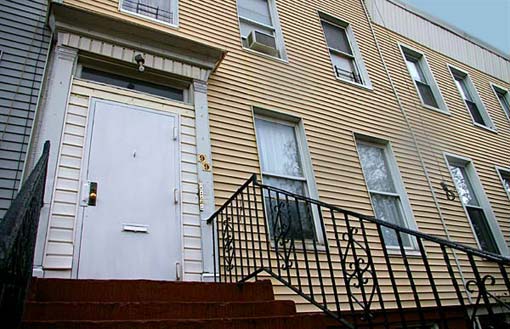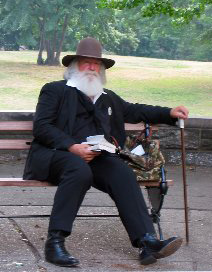Whitman Really Slept Here
Disciples of Walt want an obscure Brooklyn building to be recognized as an historic landmark.
Introduction
Tucked away in one of the oldest neighborhoods in Brooklyn, the house where Walt Whitman wrote Leaves of Grass is still there, even if the neighbors don't know about it. Now, 150 years after Whitman, the borough is booming, and fears of redevelopment threaten the house. Rachel Aviv reports.
On Ryerson Street in Clinton Hill, about a hundred yards from the Brooklyn-Queens Expressway, is a boxy three-and-a-half-story home with cream vinyl siding and six doorbells. Walt Whitman lived here in 1855, the year he published Leaves of Grass. A clump of wire hangs from the roof, and the entrance is painted several shades of white. Few people know it exists. I asked an old man, sitting on his porch across the street, if he knew of the Whitman house, and he said the name sounded familiar: “Is he the guy renting out apartments?” I said he was a dead poet, and he quickly shook his head.

Whitman lived in Brooklyn for 28 years, but this is the only home of his still standing. It was here that he received a letter from Ralph Waldo Emerson, calling Leaves of Grass the “most extraordinary piece of wit and wisdom that America has yet contributed.” “I greet you at the beginning of a great career,” he wrote, “which yet must have had a long foreground somewhere.” That foreground was in Brooklyn and Manhattan. Whitman hung out on the Bowery, went to operas downtown, drank in the Village, and wrote newspaper articles about getting rid of the barn animals that wandered through Broadway. He lived in several buildings in Fort Greene and Clinton Hill, but longed for a more permanent home: “My good daddy used to say: ‘Oh! what a comfort it is to lie down on your own floor, a floor laid with your own hands, in a house which represents your own handiwork—cellar and walls and roof!’”
For more than 10 years, scholars and fans have known about the Whitman home at 99 Ryerson Street (The New Yorker published an article about the discovery in 1995), but the block gives no indication of its history. On the corner is a Mexican-Chinese restaurant full of fake palm trees. “You would never guess that is the place where America’s greatest poet wrote his greatest work,” says Greg Trupiano, director of the Walt Whitman Project, a local community arts organization. He’s working with the Brooklyn Historical Society to try to get the exterior of the home restored to its original appearance (without displacing the tenants). “The borough is hot now,” he says, “like it was when Whitman and his family were building houses in the 1850s. We’re getting further and further from the Brooklyn he knew.”

Darrel Blaine Ford in Brooklyn
Whitman was intuitive and charismatic—a doctor friend once put him on a list of the most “cosmically conscious” people in history, along with Christ and Mohammed—and he still inspires a community of followers willing to go to great lengths to take in his aura. The smallest suggestion of a poet’s life can spark new feelings for his work; Whitman fans in particular share a reverence for everyday objects. In a recent article in the Chronicle of Higher Education, a pseudonymous columnist, who once ran his hand through a couple of preserved strands of Whitman’s beard, describes the importance of getting physically close to a subject: “My scholarly work gains momentum when I give myself over to the spiritual and emotional impulses that my rational self wants to dismiss,” he writes. He is one of a long line of writers to make pilgrimages to the house in Camden, New Jersey, where Whitman died; it still holds his waterbed and size 11 galoshes, and has a death notice nailed to the door.
The house on Ryerson Street makes imaginative leaps more difficult. “It should be a source of local and national pride,” says Trupiano, who greeted me with a backpack full of Whitman reference books snapped around his stomach. Wearing shorts and sneakers and walking briskly, he led me around downtown Brooklyn, pointing out sites that Whitman frequented. “I’m amazed how little the borough has done for him. There’s no major statue. No street named after him. We do have a terrible little park near the bridge. It’s been destroyed because of a parking lot. The description of the park is plagued with mistakes. It says that Whitman influenced Emerson—that’s not true. Emerson totally influenced him! And yet, here we can pinpoint Whitman’s residence, in the heart of Brooklyn no less.”
The five-year period before Whitman published Leaves of Grass is a shadowy time for his biographers. Whitman had shown little indication of great genius and seemed an unlikely candidate for the “origin of all poems.” In Walt Whitman’s America, David Reynolds writes that Whitman was an uninspired student whose teacher described him as a “big, good-natured lad, clumsy and slovenly.” Upon learning that he’d become famous, the teacher added, “We need never be discouraged over anyone.”
At age 21, Whitman fantasized about writing a book as if it were an easy, passing amusement: “I would compose a wonderful and ponderous book. . . . yes: I would write a book! And who shall say that it might not be a very pretty book?” The novel Whitman finally produced, Franklin Evans; Or, The Inebriate (later republished as Fortunes of a Country-Boy; Incidents in Town—and His Adventures at the South), was a morality tale about an orphan whose life was ruined by alcohol. The book was marketed with the catchphrase “Friends of Temperance, Ahoy!”
For Whitman devotees, the Ryerson house is one way to get closer to that enigmatic period during which Whitman developed into the poet who seemed to understand everyone’s problems. “I am the man. . . . I suffered. . . . I was there,” he writes. “Do I contradict myself? / Very well then. . . . I contradict myself.” “It’s an incredibly mysterious time for all of us,” says Karen Karbiener, a Whitman scholar at New York University. “What is he doing? How did this happen? He drops out of sight, does some carpentry, and for those five or six years, he’s just, you know, living in Brooklyn, working and writing. This is not a rich neighborhood—it’s working-class or tougher. It could affect a lot of people to know that Whitman was slaving away here, doing his manual labor and writing this book that changed America.”
In Leaves of Grass, Whitman describes the workers of the city as ideal citizens, self-sufficient and free. He takes pride in their competence: “The carpenter dresses his plank. . . . The machinist rolls up his sleeves. . . . The pedlar sweats with his pack on his back. . . . The floormen are laying the floor—the tinners are tinning the roof—the masons are calling for mortar.” At a time in history when Chelsea was still dirt lanes and apple blossoms, Whitman keeps track of the flowering of local industries with a fatherly joy. In his “Brooklyniana” columns, written for the Brooklyn Daily Standard in 1861 and 1862, he proudly lists every major product put out by the borough: glue, caps, clocks, vinegar, brown powder, beer, stoves, thermometers, lanterns, lifeboats, pianos, sashes, blinds. Later he reproduces the city budget in 1831, putting exclamation points after figures he finds particularly thrilling (“Grand Total . . . 10,000!!”). “You can see, reader,” he writes, “what strides we have made in exactly thirty years!”
The strides were made so quickly that few physical traces of Whitman remain in Brooklyn. According to Tim Shaw of the Brooklyn Historical Society, the area surrounding the Ryerson home, which holds the largest collection of pre–Civil War frame houses in New York City, has become increasingly desirable in the eyes of developers. “In the last year, two 1840s houses, side by side, were torn now—now it’s just an empty lot,” says Shaw. Although Whitman took pleasure in Brooklyn’s “tremendous advancement,” he felt that private middle-class dwellings—not public structures—were the most “noble buildings” and should not be destroyed for new businesses. He didn’t agree with the real estate developers, whose motto he described as “Let us level to the earth all the houses that were not built within the last ten years; let us raise the devil and break things!”
With Brooklyn’s rapid gentrification, the movement to restore the Ryerson home (before it turns into a muffin or tea shop) has gained some urgency, although it’s still in the very early stages. There’s a large community of Whitman adorers, whose interest in the poet goes well beyond the limits of purely rational scholarship. Darrel Blaine Ford, a 76-year-old who has made a pilgrimage to every city and town that Whitman visited, believes that the Ryerson home, as it is now, is a wasted resource. “I stood in front of the house once, but got very little feeling for him,” says Ford, who grows his white beard down to the middle of his chest so he can freelance as a Whitman impersonator. He uses a hickory walking stick, carries a 19th-century carpetbag, and wears a brown slouch hat with a carefully placed dent in it. (One of his gigs involves hiding in the recesses of Whitman’s tomb and then jumping out when a tour group approaches.)
The sight of Whitman’s birth home, which Ford accidentally stumbled across as a child, was what sparked his lifelong fascination. “I was nine years old, and I rode my bike farther than I’d ever ridden it before. I came into this quiet valley and saw a shabby and aging cottage with a small metal plaque that said ‘Birthplace of Walt Whitman.’ It was such a powerful experience that I remember everything about that day,” he says. “It’s important to attach your feelings to a place. Places are important. The word ‘home’—whatever it looks like—will always provide comfort to us footless wanderers.”


